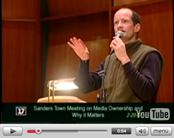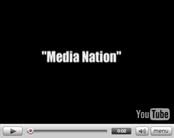Discuss E-List
Essential Resources Guide
FREE Teaching Resources
Membership Benefits
Partner Discounts
Summit 2006
FILM REVIEW: I.O.U.S.A.
“We suffer from a fiscal cancer,” explains U.S. Comptroller General David Walker. “It is growing within us. And if we do not treat it, it will have catastrophic consequences for our country.”
So begins I.O.U.S.A. – one of the most disturbing documentaries of the past year.
The film spotlights our nation’s mounting fiscal crisis – providing both a contemporary lens and historical context for understanding how today’s “debt-driven society” emerged, and what we might do to resolve one of the most intractable difficulties of our time.
“The facts aren’t liberal or conservative,” as one of the film’s observers, explains, “The facts aren’t Democrat or Republican.”
This is an issue that affects us all.
Begin with a question: how high is the federal debt?
Millions?
Billions?
Try 8.7 trillion dollars.
Just how much money is that?
One way to wrap your mind around the enormity of this number is to compare it with the United States’ GDP.
The federal debt, as a percentage of GDP (Gross Domestic Product), is 64%.
Put another way, the U.S. government is now borrowing 22 cents of every dollar it spends.
The film’s heroes are Americans working tirelessly to educate the country’s citizens about the nature of the crisis: the Concord Coalition, a think tank focusing on the fiscal crisis, concerned young people, politicians like Paul Tsongas, Ross Perot and Ron Paul (no mention of Ralph Nader, oddly). The villains? Gutless government officials seem to bear the brunt of the film’s quiet outrage.
I.O.U.S.A. suggests that the 21st century United States faces four serious deficits at this particular moment.
1. A Budget Deficit
In 1789, the national debt was $70 million dollars – 40% of the federal budget. The Founders worked quickly, the film suggests, to pay this down. A series of wars – Civil, Great, World War II – brought cycles of financial hardship to the federal government. During the last thirty years, the U.S. government has seen more than 30 annual budget deficits, and only five surpluses. But it was the Reagan years, oddly enough, given the “Morning in America- Government is Bad” rhetoric, that saw the federal budget deficit skyrocket, with a moment of sanity during the Clinton/Bob Rubin “go go” 1990s.
2. A Savings Deficit
This section opens with the brilliant “Saturday Night Live” skit mocking “saved money” (Steve Martin at his best – “Shouldn’t I buy stuff before I have the money”?) and focuses on Americans’ propensity to spend cash they don’t have. Citizens’ savings rate is the lowest it has been in decades, a result of our “live for today, easy credit, consumption-oriented” attitude. Is this a result of personal choice? The film suggests that a variety of forces are at play here: the collapse of a “sound money” supply and the Federal Reserve’s tendency to encourage enthusiastic paper money printing and debt-driven spending in the name of fighting inflation. The film channels Texas republican and maverick Ron Paul here, the champion of a strict/hard money policy, taking on Alan “irrational exuberance” Greenspan, the Federal Reserve chairman, in Congressional hearings.
3. A Balance of Payment/Trade Deficit
The U.S. is dead last among all nations if the world in terms of a “trade deficit.” Which is to say – the United States is buying more than we are selling, with foreign creditors carrying much of our borrowed debt. China, the country (along with Saudi Arabia and Israel) with whom the U.S. has a special relationship, is the second largest holder of U.S. T-Bills, and makes all of our stuff in their factories, saving us the trouble of doing little more than buying their manufactured goods. Need I say more?
4. A Leadership Deficit
So – we owe roughly $70,000 per American family in debt, according to Seymour Hersh’s “National Debt Clock.” And, while the deficit doubled on Mr. Bush’s watch (such as it was), it is too easy to blame one party or another for a systemic and long-term problem that has a variety of roots: see the very heart of our national banking system, for example, and our own personal predilections.
As this crisis’ “toxic mix” deepens – entering 2009, we’re staring a $10 trillion federal debt in the face - what can we do?
As individuals, we can pay down our own personal debts, stop spending money we don’t have, SAVE money (huh?), do more with less, explore local currencies, support local and employee-owned businesses, and explore other financial alternatives to the current status quo, including living within our means. Easier said than done, of course.
At the national level? Full disclosure: I’m a secessionist who believes that the U.S. Empire is too deeply broken to fix. The Roman Empire fell, the film suggests, for three reasons: moral decay, imperial overstretch, and domestic financial collapse. No easy answers here, especially because elite lending classes (read: the rich and powerful) have figured out how to game the system to their best advantage, leaving the rest of us poor slobs holding the “debt bag” and wondering: what the heck is going on?
I.O.U.S.A. helps to answer this very important question.



![View your cart items []](/sites/default/modules/ecommerce/cart/images/cart_empty.png)





